Accessibility is the practice of making information, activities, and/or environments available to all. Typically we view accessibility with the lens of making locations, environments, experiences and services available so people with disabilities may use them freely without difficulty.
For example, wheelchair ramps for buildings, elevators, curb cuts in sidewalks, providing braille, or large print materials for people with vision impairment, or sign language interpreters and live captioning at events for people with processing or hearing disabilities (Ladau, 2021). More than 1 billion people around the world are disabled (Ladau, 2021), and this is a substantial population for which accessibility is vital.
However, it’s often found that accessibility often brings benefits for everyone. Ask anyone who pushes a stroller or rides a bike, and they can tell you how often they also benefit from accessible design.
How does accessibility apply to the web?
Web accessibility refers to the best practices that allow users with disabilities to access your website. This may mean for example, people with physical disabilities that would need keyboard navigation, or people with visual impairments that require high contrast text or the use of screen readers.
Many jurisdictions (i.e. The US, UK and Ontario) have mandated web accessibility for government websites and for companies above a certain threshold in size. The mandates typically include adherence to the Web Content Accessibility Guidelines (WCAG), versions 2.0 and 2.1. These guidelines were published by the World Wide Web Consortium (W3C) who are the main international standards organization for the Internet (Wikipedia contributors, 2022).
In the last century accessible design has become more commonplace (although still not perfect) and ingrained within the building codes of many places for newly constructed buildings and facilities. Think of accessible parking spaces, bathrooms, ramps, and push buttons for doors. The natural progression now is for accessible design to apply to the web in order to make the internet more inclusive for all. As the internet has become our first step in accessing many services, products and businesses, especially since the pandemic, it is more crucial than ever for web accessibility be put in place so people with disabilities are able to access the internet freely.
References:
Ladau, E. (2021, September 7). Demystifying Disability: What to Know, What to Say, and How to Be an Ally. Ten Speed Press.
Wikipedia contributors. (2022, September 6). Web Content Accessibility Guidelines. Wikipedia. Retrieved September 20, 2022, from https://en.wikipedia.org/wiki/Web_Content_Accessibility_Guidelines
